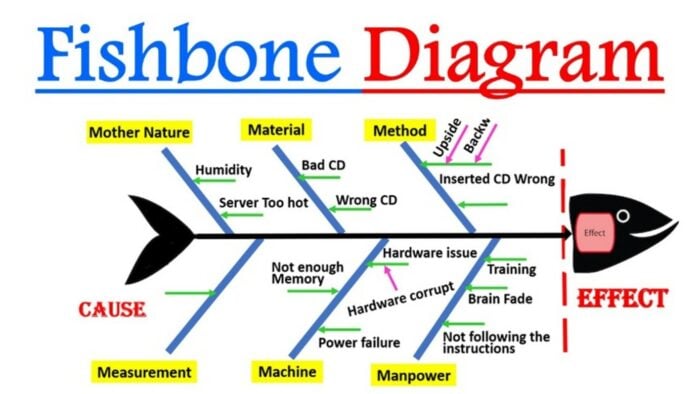We are hearing a lot these days about “getting to the root of the problem” including fixing Boeing’s 737 jet problems and in the recent obituary for Ford Motor Company’s CEO in the 1980s, Donald E. Petersen1:
“A common quip was that the letters spelling Ford … stood for ‘fix or repair daily’.”
“Petersen brought in quality consultant W, Edward Deming, then in the 80s, who had long been revered in Japan but ignored in the U.S. The strategy for quality control shifted from spotting defects in finished cars to designing and making them right in the first place.”
“If Ford focuses on better products, profits would follow,” Petersen said, adding: “Managing only for profits is like playing tennis with your eye on the scoreboard, and not on the ball.”
As a result, “Ford lost billions in the early 1980s but then surged back into the black and outperformed General Motors and Chrysler in the second half of the decade.”
I’ve been a big fan of Deming, Quality Circles, and Philip Crosby’s Quality is Free2 thesis, and have written extensively about this in all three of my books3, garnering this book review headline for my first book: “If you want to be loved, just do it right.”4
Of course, the challenge is figuring out how to identify the defects and which ones to tackle. Here is where Deming’s statistical process control (SPC), including Six Sigma, often comes into play and the classic “5 Whys” that other CustomerThink authors have introduced.5 Another popular process is the Ishikawa (fishbone) diagram6 that looks like this:

In the past, filling out the “spines” in this fishbone diagram has been hard work, listening to hundreds of customer phone calls or text messages, debating their relative weights, and brainstorming possible solutions. With the advent of AI and LLM, conducting root cause analysis (RCA) is much easier, leaving more time to test these solutions and implement fixes much faster.
How can AI and LLM do this for us? Here are five steps that you can take today, with greater accuracy arriving every day!
1. Determine the customer intents
Don’t rely on inaccurate agent coding across hundreds, if not thousands, of possible intents — the reason why the customer bothered to contact you for help, also known as “the golden 30 seconds” after the agent says, “How can I help you?” For several years, speech and text analytics vendors have attempted to replace agent coding, but their solutions are not purpose-built, and they often attempt to replicate the extant hundreds of intents, rendering a 30-40% “unrecognized” code. Bespoke AI intent generators achieve close to 100% accuracy, the first step to root cause analysis. They do this by producing a much shorter list of intents (such as “Why is my bill so high?” or “How can I upgrade my Internet speed?”) that are easier to identify with similar expressions and keywords to close any gaps.
2. Quantify each intent’s costs and customer pain points
Don’t rely on volumes and overall KPIs. Producing total costs for each intent (volumes X agent costs X handle time) + (downstream costs such as credits, replacements, or truck rolls) is far more meaningful to establish ROI using RCA’s solutions. Similarly, producing multiple customer pain points metrics by intent like transactional NPS or churn will contribute to crisp RCA. We’ve seen that some intents possess a 4x churn versus average customer churn, so wouldn’t they become initial candidates to attack?
3. Select which customer interactions to analyze
Picking contacts at random is not projectable. Using AI’s ability is critical to sort through all customer interactions to find the ones that skilled staff should listen to (yes, there’s still a need for humans here!) and that the AI tools themselves will score. Find more than 200 contacts for your team to analyze, scoring each contact’s initial intent (reason), any subsequent issue raised, handle time, and to which fishbone spine the contact should be assigned. Automated analyses can expand these numbers into the thousands, confirming and extending the root causes.
4. Produce customer sentiment
Don’t assume that all customer contacts match average scores. We need to dig well beneath averages (see my CustomerThink post “Get Rid of Average Thinking, Make Every Experience Count”7) to reveal the “long tails” and range that more accurately represents customer experiences such as handle times 3-6x the AHT, 3rd or 4th contacts, etc. As noted above, this starts by using AI to produce intent-level customer KPIs but it goes much further to reveal customer sentiment at the beginning, throughout, and at the end of the interaction. AI will then highlight where customers started passive or happy but ended confused or irate, and these intents merit inclusion in the fishbone diagram.
5. Extract possible root causes and fixes
Instead of spit-balling solutions, AI can isolate intents and customer interactions with contractions. This is a good way to confirm customer frustration and possible solutions — “Why can’t I do this myself?” or “Didn’t I already tell you about this?” the latter also signaling a repeat contact or, as I’ve defined them for years, “Snowballs” that need to be “melted” (resolved). When I ran customer service at Amazon 25 years ago, we used an early version of text analytics to extract from email queues all messages including one or more of the words “ruined,” “Santa,” or “Christmas,” enabling my tier 3 agents to zero in on these messages, often “locking” (resolving) snowballs since customers were becoming anxious. Today, AI can take this so much further, spotting spines on the fishbone and possible fixes.
In short, AI and LLM can accelerate your root cause analysis chops and move much faster into initial solution spaces. Boeing, are you listening?
Notes:
1 James R. Hagerty, “Ford CEO, Known as Consensus Builder, Improved Auto Quality”, The Wall Street Journal April 27-28, 2024
2 Philip B. Crosby’s 1980 best-seller Quality is Free: The Art of Making Quality Certain; I still have my paperback copy that looks exactly like this: https://tinyurl.com/4aje2v87
3 Book #1: Bill Price & David Jaffe, The Best Service is No Service: How to Liberate Your Customers from Customer Service, Keep Them Happy & Control Costs, Wiley 2008
Book #2: Bill Price & David Jaffe, Your Customer Rules! Delivering the Me2B Experiences That Today’s Customers Demand, Wiley 2015.
Book #3: Bill Price & David Jaffe, The Frictionless Organization: Deliver Great Customer Experiences with Less Effort, Barrett-Koehler June 2022.
4 Alan Mitchell reviewing The Best Service is No Service in the Financial Times 27 March 2008: https://www.ft.com/content/3f719b9c-fb5b-11dc-8c3e-000077b07658
5 Adam Ramshaw, 7 October 2013 “5 Whys Root Cause Analysis Template and Process”
https://customerthink.com/5_whys_root_cause_analysis_template_and_process/ accessed 9 May 2024
6Lean Manufacturing & Six Sigma Worldwide, https://www.linkedin.com/pulse/fishbone-diagram-digital-elearning/
7Bill Price, December 13, 2025, https://customerthink.com/get-rid-of-average-thinking-make-every-experience-count/



